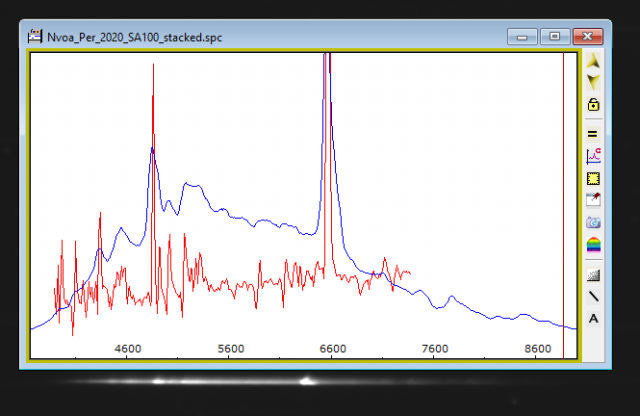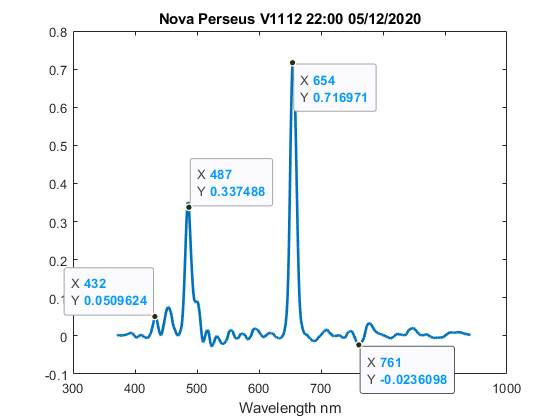› Forums › Spectroscopy › Novae Cas and Per 2020 H alpha at medium resolution
- This topic has 10 replies, 5 voices, and was last updated 5 years ago by
 Philip Masding.
Philip Masding.
-
AuthorPosts
-
2 December 2020 at 5:16 pm #574809
 Robin LeadbeaterParticipant
Robin LeadbeaterParticipantTaken on the same night using the LHIRES and 1200l/mm grating added to my personal page
2 December 2020 at 5:21 pm #583439 Dr Andrew SmithParticipant
Dr Andrew SmithParticipantVery modern using nm. Fine observations.
Regards
2 December 2020 at 8:36 pm #583440 Robin LeadbeaterParticipant
Robin LeadbeaterParticipantActually I debated that briefly. The wavelength range in the images is approximate as the dispersion is non linear and it is a crop and I could not be bothered to work out the exact wavelengths to the nearest Angstrom. I used nm as 10 Angstrom was close enough 🙂
2 December 2020 at 8:50 pm #583441 Stewart John BeanParticipant
Stewart John BeanParticipantI was taught in Angstrom but adapted to nm in my professional life. You get used to anything in the end.
Stewart
3 December 2020 at 1:11 pm #583451 Robin LeadbeaterParticipant
Robin LeadbeaterParticipantnm I can cope with (though the need to include a decimal point when defining well known lines is ugly). It is the use of Janskys for flux in optical spectra instead of the traditional (but definitely not SI) erg/cm2/sec/Angstrom that really throws me when I see it as being based on frequency, it completely changes the shape of the spectrum.
6 December 2020 at 9:05 am #583467 Dr Paul LeylandParticipant
Dr Paul LeylandParticipantI used cm^-1 as an energy unit for a few years when doing my DPhil research.
In those units red is about 15000, yellow about 20000 and violet about 25000.
6 December 2020 at 9:14 am #583468 Dr Paul LeylandParticipant
Dr Paul LeylandParticipant(though the need to include a decimal point when defining well known lines is ugly)
I know what you mean. It is so much prettier to write 5889.950Å and 5895.924Å than 588.9950nm and 589.5924nm. It means you get to use a non-ASCII character. 😉
To be serious now: my work was done with a spectrograph with a resolution in excess of 300,000. The sodium D lines were separated by about a centimetre at the focal plane. Decimal points were essential, even when using wavenumbers (cm^-1) because the centroids of narrow lines could often be measured to better than 0.01cm^-1.
7 December 2020 at 1:03 am #583475 Robin LeadbeaterParticipant
Robin LeadbeaterParticipantI mean for identification (ie shorthand to identify the line in question) not for stating the measured wavelength. (I can measure that to a precision of up to 0.01A). In papers on astrophysics you only need to say for example Na 5890, Na 5896, He 6678, DIB 6613 etc for the reader to know the line you are talking about. That’s what I meant by avoiding the ugly decimal point.
8 December 2020 at 10:57 pm #583493 Philip MasdingParticipant
Philip MasdingParticipantI tried taking a spectrum of the nova and got an apparent emission feature between H beta and H gamma. Very similar to David Strange’s result now in the recent images page. Is this feature real?
8 December 2020 at 11:49 pm #583494 Robin LeadbeaterParticipant
Robin LeadbeaterParticipantYes it is real. I also see it in a Star Analyser spectrum I took a couple of days ago. It is a blend of several lines ~4500-4600A unresolved at the Star Analyser resolution Here it is overlaid on a spectrum from David Boyd in the BAA database (red)
(It looks quite intense relative to H gamma because H lines are narrow compared with the Star Analyser resolution so are reduced in height)
Cheers
Robin
 9 December 2020 at 9:39 am #583498
9 December 2020 at 9:39 am #583498 Philip MasdingParticipant
Philip MasdingParticipantHi Robin,
Thanks for you reply. Nice to know my observation and processing hadn’t created a spurious result! I’ve attached my result.
Cheers
Phil
-
AuthorPosts
- You must be logged in to reply to this topic.
